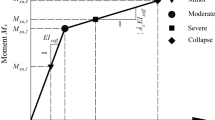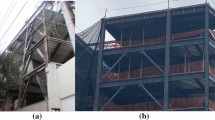Abstract
Reinforced concrete (RC) rigid-frame bridges with tall hollow piers were widely constructed in Southwestern China, an earthquake-prone area. For such bridges, the seismic damages may be underestimated if multiple bends of tall piers are overlooked using a conventional damage measure such as the drift ratio. Moreover, the seismic damage assessment can be inaccurate if tall piers’ shear damages are ignored using the sectional curvature as a damage measure. Along these lines, this paper proposes a novel seismic damage measure, the piecewise drift ratio (PDR), involving both shear effects and multiple-bend deformations; it has been validated by hybrid tests and analyzed employing fragility curves. Damage state limits represented by the PDR are estimated through statistical analysis of the 40 existing tests of hollow piers. To validate the PDR, a finite element model of an RC rigid-frame bridge with two tall piers was established and adequately calibrated based on model-updating hybrid simulations. To comprehensively evaluate the PDR, ground motions were selected and grouped into four categories by identifying their first two-class nature frequency and their amplitude ratio; to determine fragility curves, both the spectral acceleration at the fundamental period with 5% dam**, Sa(T1, 5%), and the peak ground acceleration have been adopted as intensity measures. Results show the effectiveness of the proposed PDR, provide a more severe ground motion for assessment, and reveal the high exceedance probability of the complete damage state of tall piers under some potential seismic scenarios.















Similar content being viewed by others
References
Abbiati G, Broccardo M, Abdallah I et al (2021) Seismic fragility analysis based on artificial ground motions and surrogate modeling of validated structural simulators. Earthq Eng Struct Dyn 2:1–20
Baig MA, Ansari MdI, Islam N, Umair M (2022) Damage assessment of circular bridge pier incorporating high-strength steel reinforcement under near-fault ground motions. Mater Today Proc 64(1):488–498
Berry M, Eberhard MO (2003) Performance models for flexural damage in reinforced concrete columns. PEER Report 2003/18
Berry M, Eberhard MO (2003) Performance models for flexural damage in reinforced concrete columns, PEER Report 2003/18; Pacific Earthquake Engineering Research Center, College of Engineering, University of California, Berkeley
Ceravolo R, Demarie GV, Giordano L, Mancini G, Sabia D (2009) Problems in applying code-specified capacity design procedures to seismic design of tall piers. Eng Struct 31(8):1811–1821
Chen X, Guan Z, Li J et al (2018) Shake table tests of tall-pier bridges to evaluate seismic performance. J Bridg Eng 23(9):04018058
Chen X, Li J, Guan Z (2020) Fragility analysis of tall pier bridges subjected to near-fault pulse-like ground motions. Struct Infrastruct Eng 16(8):1082–1095
Chopra AK, Goel RK (2002) A model pushover analysis procedure for estimating seismic demands for buildings. Earthq Eng Struct Dyn 31(3):561–582
Chung YS, Lee DH, Chang KP et al. (2004) Curvature variation of earthquake-experienced RC bridge pier in the plastic hinge region. In: 13th world conference on earthquake engineering, Vancouver, Canada. Accessed 1–6 Aug 2004
Cornell CA, Jalayer F, Hamburger RO et al (2002) Probabilistic basis for 2000 sac feder al emergency management agency steel moment frame guidelines. J Struct Eng 128(4):526–533
Cosenza E, Manfredi G (2000) Damage indices and damage measures. Prog Struct Eng Mater 2(1):50–59
Cui H, He S, Song Y (2010) Experimental study on antiseismic ductility of hollow rectangular thin-walled pier. J Highw Transp Res Dev 27(6):58–63 (in Chinese)
Delgado R, Delgado P, Pouca NV et al (2009) Shear effects on hollow section piers under seismic actions: experimental and numerical analysis. Bull Earthq Eng 7(2):377–389
Du XL, Chen MQ, Han Q (2011) Experimental evaluation of seismic performance of reinforced concrete hollow bridge columns. J Vib Shock 30(11):254–259 (in Chinese)
Han Q, Zhou YL, Du XL (2015) Seismic performance of reinforced concrete rectangular hollow bridge columns. Eng Mech 32(03):28–40 (in Chinese)
Jiang H (2015) Study on damage mechanism of thin-walled hollow square bridge piers. Degree Paper, 2015, Institute of Engineering Mechanics, China Earthquake Administration, Harbin
Li J, Spencer JBF, Elnashai AS (2013) Bayesian updating of fragility functions using hybrid simulation. J Struct Eng 139(7):1160–1171
Liu Y, Paolacci F, Lu DG (2017) Seismic fragility of a typical bridge using extrapolated experimental damage limit states. Earthq Struct 13(6):599–611
Liu Y, Mei Z, Wu B et al (2020) Seismic behaviour and failure-mode-prediction method of a reinforced concrete rigid-frame bridge with thin-walled tall piers: investigation by model-updating hybrid test. Eng Struct 2020(208):110302
Liu Y, Mei Z, Lu DG et al (2021) Seismic risk and resilience assessment of composite bridges using hybrid fragility. Bridge maintenance, safety, management, life-cycle sustainability and innovations. CRC Press, pp 3177–3183
Mei Z, Wu B, Bursi OS et al (2018) Hybrid simulation of structural systems with online updating of concrete constitutive law parameters by unscented Kalman filter. Struct Control Health Monit 25(2):e2069
Mei Z, Wu B, Bursi OS et al (2019) Hybrid simulation with online model updating: application to a reinforced concrete bridge endowed with tall piers. Mech Syst Signal Process 2019(13):533–553
Mohammed SI (2011) Experimental study on seismic behavior of rectangular hollow pier. Chang’An University, **’An
Padgett JE, DesRoches R (2008) Methodology for the development of analytical fragility curves for retrofitted bridges. Earthq Eng Struct Dyn 37(8):1157–1174
Pan Y, Ventura CE, Tannert T (2020) Damage index fragility of low-rise light-frame wood buildings under long duration subduction earthquakes. Struct Saf 2020(84):101940
Park YJ, Ang AHS (1985) Mechanistic seismic damage model for reinforced concrete. J Struct Eng 111(4):722–739
Pinto AV, Molina J, Tsionis G (2003) Cyclic tests on large-scale models of existing bridge piers with rectangular hollow cross-section. Earthq Eng Struct Dyn 32:1995–2012
Rakesh K, Goel AKC (2005) Role of higher-mode pushover analyses in seismic analysis of buildings. Earthq Spectra 21(4):15
Shao CJ, Qi QM, Wei W et al (2022) Experimental study on dunctile seismic performance of rectangular concrete hollow columns. J Southwest Jiaotong Univ 57(01):129–138 (in Chinese)
Sun Z-G, Wang D-S, Guo X et al (2013) Comparative study on shear strength of RC thin-walled hollow bridge piers under seismic effect. Chin Civ Eng J 46(12):81–89
Tubaldi E, Tassotti L, Dall’Asta A et al (2014) Seismic response analysis of slender bridge piers. Earthq Eng Struct Dyn 43:1503–1519
Wei W (2019) Study on ductility and seismic behavior of concrete hollow pier based on quasi-static test. Southwest Jiaotong University, Chengdu (in Chinese)
Wei W, Yuan Y, Igarashi A et al (2021) Experimental investigation and seismic fragility analysis of isolated highway bridges considering the coupled effects of pier height and elastomeric bearings. Eng Struct 233:111926
Yang G, Wu B, Wang Z et al (2023) Control nodes based loading method: a versatile approach for multi-degree-of freedom loading in quasi-static tests and hybrid simulations. Earthq Eng Struct Dyn 52(1):3–26
Zacharenaki A, Fragiadakis M, Assimaki D et al (2014) Bias assessment in incremental dynamic analysis due to record scaling. Soil Dyn Earthq Eng 2014(67):158–168
Acknowledgments
The authors gratefully acknowledge the financial supports from the National Natural Science Foundation of China (Grant No. 51908384) and Zhejiang Provincial Natural Science Foundation of China (Grant No. LTGG23E080004, LTGG24E080003). This paper is also financed by the National Key Research and Development Program of China (Grant No. 2021YFB2600500), Basic Social Development Science and Technology Project (Grant No. S20220006, G2023038), and the National Natural Science Foundation of China (Grant No. 52078398). The fourth author acknowledges the Italian Ministry of Universities and Research (MUR) in the framework of the project DICAM-EXC (Departments of Excellence 2023-2027, grant L232/2016).
Author information
Authors and Affiliations
Corresponding author
Ethics declarations
Conflict of interest
The authors declare that there is no conflict of interest regarding the publication of this paper.
Additional information
Publisher's Note
Springer Nature remains neutral with regard to jurisdictional claims in published maps and institutional affiliations.
Rights and permissions
Springer Nature or its licensor (e.g. a society or other partner) holds exclusive rights to this article under a publishing agreement with the author(s) or other rightsholder(s); author self-archiving of the accepted manuscript version of this article is solely governed by the terms of such publishing agreement and applicable law.
About this article
Cite this article
Mei, Z., Liu, Y., Wu, B. et al. A measure for seismic multiple bends and shear damage patterns of RC rigid-frame bridge tall piers. Bull Earthquake Eng 22, 4609–4633 (2024). https://doi.org/10.1007/s10518-024-01914-z
Received:
Accepted:
Published:
Issue Date:
DOI: https://doi.org/10.1007/s10518-024-01914-z





